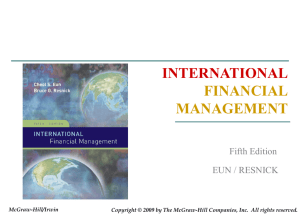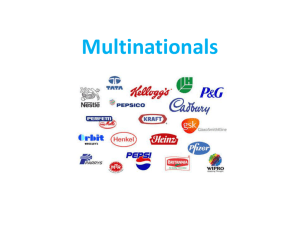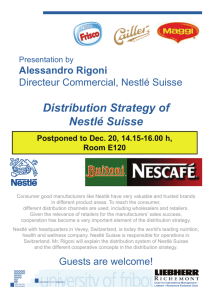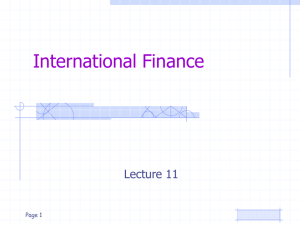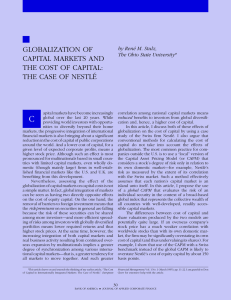Chapter 1
advertisement
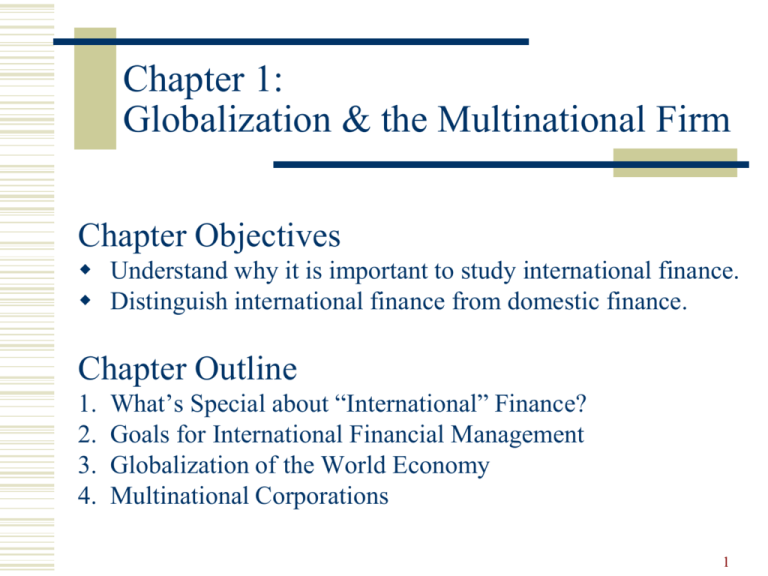
Chapter 1: Globalization & the Multinational Firm Chapter Objectives Understand why it is important to study international finance. Distinguish international finance from domestic finance. Chapter Outline 1. 2. 3. 4. What’s Special about “International” Finance? Goals for International Financial Management Globalization of the World Economy Multinational Corporations 1 What’s Special about “International” Finance? Foreign Exchange Risk Political Risk Market Imperfections Expanded Opportunity Set 2 What’s Special about “International” Finance? Foreign Exchange Risk The risk that foreign currency profits may evaporate in home currency terms due to unanticipated unfavorable exchange rate movements. e.g. Recent surge in Canadian dollar value against US dollar Political Risk Sovereign governments have the right to regulate the movement of goods, capital, and people across their borders. These laws sometimes change in unexpected ways. e.g. Chinese ban on canola imports from Canada in 2002 3 Decomposition of Political Risk 4 What’s Special about “International” Finance? Market Imperfections Legal restrictions on movement of goods, people, and money Transactions costs Shipping costs Tax arbitrage 5 The Example of Nestlé’s Market Imperfection Nestlé used to issue two different classes of common stock bearer shares and registered shares. Foreigners were only allowed to buy bearer shares (More expensive). Swiss citizens could buy registered shares. On November 18, 1988, Nestlé lifted restrictions imposed on foreigners, allowing them to hold registered. Following this, the price spread between the two types of shares narrowed dramatically. This implies that there was a major transfer of wealth from foreign shareholders to Swiss shareholders. Foreigners holding Nestlé bearer shares were exposed to political risk in a country that is widely viewed as a haven from such risk. The Nestlé episode illustrates both the importance of considering market imperfections and the peril of political risk. 6 Nestlé’s Foreign Ownership Restrictions 12,000 10,000 Bearer share SF 8,000 6,000 4,000 Registered share 2,000 0 11 20 31 9 18 24 Source: Financial Times, November 26, 1988 p.1. Adapted with permission. 7 What’s Special about “International” Finance? Expanded Opportunity Set It doesn’t make sense to play in only one market. True for corporations as well as individual investors. Investor’s perspective Risk reduction through international diversification. Corporation’s perspective Access to cheaper production inputs Access to consumers Access to capital 8 Goals for International Financial Management Shareholder Wealth Maximization Predominant in North America, UK Goal: Maximize return to shareholders “one-share-one-vote” Agency theory dictates managerial behaviour Stakeholder Welfare Maximization France, Germany All parties associated with the firm are treated equally (shareholders, employees, customers, suppliers, creditors, govt.) Goal: Maximize long-term return for all interest groups In Japan, Korea, managers have typically sought to maximize the value of the keiretsu-a family of firms to which the individual firms belongs- through increased market share 9 Other Goals As shown by recent corporate scandals at companies like Enron, WorldCom, managers may pursue their own private interests at the expense of SHs when they are not closely monitored. These calamities have painfully reinforced the importance of corporate governance i.e. the financial and legal framework for regulating the relationship between a firm’s management and its shareholders. These types of issues can be much more serious in many other parts of the world, especially emerging and transitional economies, such as Indonesia, Korea, and Russia, where legal protection of shareholders is weak or virtually non-existing. No matter what the other goals, they cannot be achieved in the long term if the maximization of shareholder wealth is not given due consideration. 10 Globalization of the World Economy: Recent Trends Emergence of Globalized Financial Markets Advent of the Euro Trade Liberalization and Economic Integration Privatization 11 Emergence of Globalized Financial Markets Deregulation of Financial Markets coupled with Advances in Technology have greatly reduced information and transactions costs, which has led to: Financial Innovations, such as Currency futures and options Multi-currency bonds Cross-border stock listings International mutual funds 12 Advent of the Euro A momentous event in the history of world financial systems. Currently more than 320 million Europeans in 17 countries are using the common currency on a daily basis.(Belgium, Germany, Greece, Spain, France, Ireland, Italy, Luxembourg, the Netherlands, Austria, Portugal, Slovenia, Slovakia, Estonia, Finland, Malta, and Cyprus). The “transaction domain” of the euro may become larger than the U.S. dollar’s in the near future. For more info on euro, visit the European Central Bank's Web site at www.ecb.int. 13 Trade Liberalization and Economic Integration Over the past 50 years, international trade increased about twice as fast as world GDP. There has been a sea change in the attitudes of many of the world’s governments who have abandoned mercantilist views and embraced free trade as the surest route to prosperity for their citizenry. The General Agreement on Tariffs and Trade-GATT (later replaced with WTO) a multilateral agreement among member countries has reduced many barriers to trade. The North American Free Trade Agreement (NAFTA) calls for phasing out impediments to trade between Canada, Mexico and the U.S. over a 15year period. For Canada, the ratio of exports to GDP has increased dramatically from 19.2% in 1973 to 45.2% in 2003. The increased trade will result in increased numbers of jobs and a higher standard of living for all member nations. 14 Privatization The selling off state-run enterprises to investors is also known as “Denationalization”. Often seen in socialist economies in transition to market economies. By most estimates this increases the efficiency of the enterprise. Often spurs a tremendous increase in cross-border investment. It Fuels economic growth 15 Multinational Corporations A firm that has incorporated on one country and has production and sales operations in other countries. There are about 60,000 MNCs in the world. Many MNCs obtain raw materials from one nation, financial capital from another, produce goods with labor and capital equipment in a third country and sell their output in various other national markets. Advantages of the global economy for MNCs: 1. Spreading fixed costs like R&D over global sales. 2. Global purchasing power over suppliers 3. Lower labor costs, maybe. 4. Better access to capital. 5. Greater operational efficiencies 16 Top 10 MNCs by Revenues 2011 1 Wallmart United States 2 ExxonMobile Corporation United States 3 Royal Dutch/Shell Group Netherlands/ UK 4 BP UK 5 Sinopec China 6 Toyota Motor Corporation Japan 7 Petro China China 8 TotalFina SA France 9 Chevron United States 10 Japan Post Holdings Japan 17 Mini Case: Nike’s Decision Nike, a U.S.-based company with a globally recognized brand name, manufactures athletic shoes in such Asian developing countries as China, Indonesia, and Vietnam using subcontractors, and sells the products in the U.S. and foreign markets. The company has no production facilities in the United States. In each of those Asian countries where Nike has production facilities, the rates of unemployment and underemployment are quite high. The wage rate is very low in those countries by the U.S. standard; hourly wage rate in the manufacturing sector is less than one dollar in each of those countries, which is compared with about $18 in the U.S. In addition, workers in those countries often are operating in poor and unhealthy environments and their rights are not well protected. Understandably, Asian host countries are eager to attract foreign investments like Nike’s to develop their economies and raise the living standards of their citizens. Recently, however, Nike came under a world-wide criticism for its practice of hiring workers for such a low pay, “next to nothing” in the words of critics, and condoning poor working conditions in host countries. Evaluate and discuss various ‘ethical’ as well as economic ramifications of Nike’s decision to invest in those Asian countries. 18

